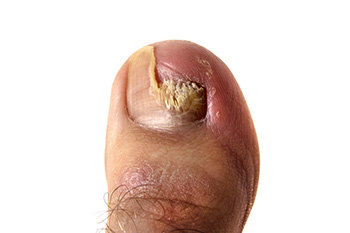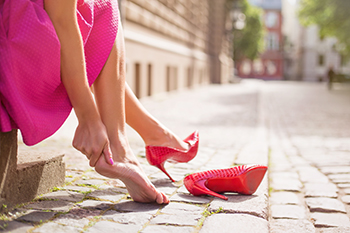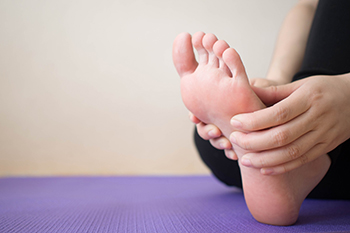Connect With Us
Blog
Items filtered by date: February 2023
Toenail Fungus Symptoms

Toenail fungus is a common nail disorder. It is a fungal infection, and research has shown it affects approximately half of Americans by the time they reach age 70. The fungus that causes this ailment enters the body through small cuts in the nail and may spread to the other nails if prompt medical attention is not sought. This fungus lives in warm environments like public swimming pools, locker rooms, and shower room floors. This condition gradually progresses, and one of the first signs can be yellowed toenails, or white spots on the toenail. This is followed by a change in texture, causing the nail to become brittle and possibly fall off. Preventive measures can include wearing appropriate shoes when frequenting these types of areas, such as flip flops or water shoes, and it is beneficial to refrain from sharing shoes and socks. If you have toenail fungus, it is strongly suggested that you visit a podiatrist who can offer you the correct treatment techniques.
For more information about treatment, contact David Mansky, DPM of Mansky Podiatry. Our doctor can provide the care you need to keep you pain-free and on your feet.
Toenail Fungus Treatment
Toenail fungus is a condition that affects many people and can be especially hard to get rid of. Fortunately, there are several methods to go about treating and avoiding it.
Antifungals & Deterrence
Oral antifungal medicine has been shown to be effective in many cases. It is important to consult with a podiatrist to determine the proper regiment for you, or potentially explore other options.
Applying foot powder on the feet and shoes helps keep the feet free of moisture and sweat.
Sandals or open toed shoes – Wearing these will allow air movement and help keep feet dry. They also expose your feet to light, which fungus cannot tolerate. Socks with moisture wicking material also help as well.
If you have any questions please feel free to contact our office located in Hastings, MI . We offer the newest diagnostic tools and technology to treat your foot and ankle needs.
What Is High Heel Syndrome?

Although it might not seem immediately obvious, the kinds of shoes that you wear can have a discernible impact on the health of your feet. For example, if you wear non-supportive, flimsy footwear, this can spell trouble for the strength and resilience of your feet. High heels are one such kind of potentially detrimental footwear. The impact that high heels can have on your feet and body is sometimes referred to as high heel syndrome. As a result of overuse of high heels, an individual might experience anatomical changes in their legs. Typically these individuals will have Achilles tendons that are more stiff. When an individual is experiencing high heel syndrome, they may benefit significantly from stretching exercises that target the calves. If you are someone who wears high heels frequently, consider contacting a podiatrist for more information and support.
High heels have a history of causing foot and ankle problems. If you have any concerns about your feet or ankles, contact David Mansky, DPM from Mansky Podiatry. Our doctor can provide the care you need to keep you pain-free and on your feet.
Effects of High Heels on the Feet
High heels are popular shoes among women because of their many styles and societal appeal. Despite this, high heels can still cause many health problems if worn too frequently.
Which Parts of My Body Will Be Affected by High Heels?
- Ankle Joints
- Achilles Tendon – May shorten and stiffen with prolonged wear
- Balls of the Feet
- Knees – Heels cause the knees to bend constantly, creating stress on them
- Back – They decrease the spine’s ability to absorb shock, which may lead to back pain. The vertebrae of the lower back may compress.
What Kinds of Foot Problems Can Develop from Wearing High Heels?
- Corns
- Calluses
- Hammertoe
- Bunions
- Morton’s Neuroma
- Plantar Fasciitis
How Can I Still Wear High Heels and Maintain Foot Health?
If you want to wear high heeled shoes, make sure that you are not wearing them every day, as this will help prevent long term physical problems. Try wearing thicker heels as opposed to stilettos to distribute weight more evenly across the feet. Always make sure you are wearing the proper shoes for the right occasion, such as sneakers for exercising. If you walk to work, try carrying your heels with you and changing into them once you arrive at work. Adding inserts to your heels can help cushion your feet and absorb shock. Full foot inserts or metatarsal pads are available.
If you have any questions please feel free to contact our office located in Hastings, MI . We offer the newest diagnostic and treatment technologies for all your foot and ankle needs.
Common Causes of Foot Pain

The feet undergo a great deal of wear and tear throughout a lifetime. For that reason, it is common for most people to experience some type of foot pain. Sprains and fractures are typical foot conditions that cause pain. In some cases, a bone in the foot will break, often the result of trauma, such as dropping something heavy on it. Sprains are caused by overstretching of a ligament when you land wrong on the foot. Hairline fractures are frequently the result of overuse, as may be experienced by runners or other athletes. A hammertoe can cause pain from rubbing the bone against the top of a shoe. This is caused by an imbalance between a tendon and a muscle in the toe, which makes the joint of the toe rise up. Pain in the ball of the foot, referred to as metatarsalgia, can be extremely painful. It is common among people who run and jump a lot and is often a side effect of a foot deformity, such as bunions, that changes the biomechanics of the feet. Improperly fitting footwear can also cause foot pain from corns, calluses, and blisters. If you are experiencing foot pain that will not go away or worsens, please consider seeing a podiatrist who can determine the cause and offer treatment solutions.
Foot Pain
Foot pain can be extremely painful and debilitating. If you have a foot pain, consult with David Mansky, DPM from Mansky Podiatry. Our doctor will assess your condition and provide you with quality foot and ankle treatment.
Causes
Foot pain is a very broad condition that could be caused by one or more ailments. The most common include:
- Bunions
- Hammertoes
- Plantar Fasciitis
- Bone Spurs
- Corns
- Tarsal Tunnel Syndrome
- Ingrown Toenails
- Arthritis (such as Gout, Rheumatoid, and Osteoarthritis)
- Flat Feet
- Injury (from stress fractures, broken toe, foot, ankle, Achilles tendon ruptures, and sprains)
- And more
Diagnosis
To figure out the cause of foot pain, podiatrists utilize several different methods. This can range from simple visual inspections and sensation tests to X-rays and MRI scans. Prior medical history, family medical history, and any recent physical traumatic events will all be taken into consideration for a proper diagnosis.
Treatment
Treatment depends upon the cause of the foot pain. Whether it is resting, staying off the foot, or having surgery; podiatrists have a number of treatment options available for foot pain.
If you have any questions, please feel free to contact our office located in Hastings, MI . We offer the newest diagnostic and treatment technologies for all your foot care needs.
Arthritis Can Cause Pain in the Feet and Ankles
Falling and the Feet

Falling can wreak havoc in an individual’s life. Their lifestyle may have to be altered, possibly to care for foot problems the fall may have caused. Falls are common among elderly people for various reasons. These can include failing eyesight, weakened muscles, and possible side effects from medication. Additionally, falling may happen from wearing shoes that do not fit correctly, and having tripping hazards in the household. The feet are often affected when a fall happens, which can range from incurring a broken toe to enduring an ankle sprain. There are simple fall prevention methods that can be implemented, which may help to reduce the risk of falling. These can consist of installing grab bars in the toilet and shower area, removing clutter in the living area, and improving existing lighting. If you would like more information about the importance of having fall prevention techniques, please consult with a podiatrist.
Preventing falls among the elderly is very important. If you are older and have fallen or fear that you are prone to falling, consult with David Mansky, DPM from Mansky Podiatry. Our doctor will assess your condition and provide you with quality advice and care.
Every 11 seconds, an elderly American is being treated in an emergency room for a fall related injury. Falls are the leading cause of head and hip injuries for those 65 and older. Due to decreases in strength, balance, senses, and lack of awareness, elderly persons are very susceptible to falling. Thankfully, there are a number of things older persons can do to prevent falls.
How to Prevent Falls
Some effective methods that older persons can do to prevent falls include:
- Enrolling in strength and balance exercise program to increase balance and strength
- Periodically having your sight and hearing checked
- Discuss any medications you have with a doctor to see if it increases the risk of falling
- Clearing the house of falling hazards and installing devices like grab bars and railings
- Utilizing a walker or cane
- Wearing shoes that provide good support and cushioning
- Talking to family members about falling and increasing awareness
Falling can be a traumatic and embarrassing experience for elderly persons; this can make them less willing to leave the house, and less willing to talk to someone about their fears of falling. Doing such things, however, will increase the likelihood of tripping or losing one’s balance. Knowing the causes of falling and how to prevent them is the best way to mitigate the risk of serious injury.
If you have any questions, please feel free to contact our office located in Hastings, MI . We offer the newest diagnostic and treatment technologies for all your foot care needs.
Blog Archives
- April 2025
- March 2025
- February 2025
- January 2025
- December 2024
- November 2024
- October 2024
- September 2024
- August 2024
- July 2024
- June 2024
- May 2024
- April 2024
- March 2024
- February 2024
- January 2024
- December 2023
- November 2023
- October 2023
- September 2023
- August 2023
- July 2023
- June 2023
- May 2023
- April 2023
- March 2023
- February 2023
- January 2023
- December 2022
- November 2022
- October 2022
- September 2022
- August 2022
- July 2022
- June 2022
- May 2022
- April 2022

